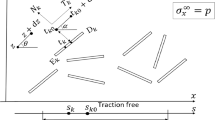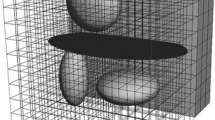Abstract
The elasticity problem for planar cracks in infinite homogeneous anisotropic media subjected to arbitrary external stress fields is considered. The problem is reduced to solving the integral equation for the displacement jump on the crack surface. An efficient numerical method of solution of this equation is proposed for media with ellipsoidal anisotropy. In the method, Gaussian radial functions shifted at the nodes of a regular grid on the crack surface are used to approximate the solution. The problem is reduces to a linear algebraic system for the coefficients of the approximation (the discretized problem). For Gaussian approximating functions, the elements the matrix of this system are presented in the forms of standard 1D-integrals. These integrals can be tabulated for small values of the arguments, and they have simple analytical asymptotics for large arguments. As the result, the matrix of the discretized problem is calculated fast. For regular grids of approximating nodes, this matrix has Toeplitz’ structure, and fast Fourier transform algorithm can be used for calculating matrix-vector products by iterative solution of the discretized problem. It substantially accelerates the construction of the numerical solutions. Examples of the solutions for circular, annular and square cracks of various orientations in a strongly anisotropic elastic medium are presented.








Similar content being viewed by others
References
Brebbia C, Dominguez J (1989) Boundary elements. An introductory course. WIT Press, McGraw Hill, NY
Crouch S, Starfield A (1983) Boundary element method in solids mechanics. Allen & Unwin Lid, London
Eskin G (1981) Boundary-value problems for elliptic pseudo-differential equations. American Mathematical Society, NY
Golub G, Van Loan C (1993) Matrix computations. John Hopkins University Press, NY
Kanaun S (1981) Crack problem in 3D anisotropic elastic medium. Appl Math Mech 44:361–370
Kanaun S (2007) Elliptical crack in an anisotropic elastic medium subjected to a constant external field. Int J Fract 148:95–102
Kanaun S (2007) Fast solution of the 3D elasticity problem for a planar crack of arbitrary shape. Int J Fract 148:435–442
Kanaun S (2020) Heterogeneous medium: local fields, effective properties, and wave propagation. Elsevier, Amsterdam
Kanaun S (2021) An ellipsoidal inclusion and an elliptical crack in the elastic media with ellipsoidal anisotropy. Int J Fract 227:133–136
Kanaun S, Levin V (2008) Self-consistent methods for composites, vol I. Static problems. Springer, Dordrecht
Kanaun S, Levin V (2009) Elliptical cracks arbitrary oriented in 3D-anisotropic elastic media. Int J Eng Sci 47:777–792
Kanaun S, Markov A (2014) Stress fields in 3D-elastic material containing multiple interacting cracks of arbitrary shapes: efficient calculation. Int J Eng Sci 75:118–134
Kunin I (1983) Elastic medium with microstructure. II. Springer, Berlin
Markov A, Kanaun S (2017) Interactions of cracks and inclusions in homogeneous elastic media. Int J Fract 206(1):35–48
Markov A, Abaimov S, Sevostianov I, Kachanov M, Kanaun S, Akhatov I (2019) The effect of multiple contacts between crack faces on crack contribution to the effective elastic properties. Int J Solids Struct 163:75–86
Maz’ya V, Schmidt G (2007) Approximate approximation, vol 141. Mathematical surveys and monographs. American Mathematical Society, Providence, RI
Pan E, Yuan F (2000) Boundary element analysis of three-dimensional cracks in anisotropic solids. Int J Numer Meth Eng 48:211–237
Peterson A, Ray S, Mittra R (1993) Computational methods for electromagnetics. IEEE Press, NY
Pouya A (2011) Ellipsoidal anisotropy in linear elasticity: approximation models and analytical solutions. Int J Solids Struct 48:2245–2254
Press W, Flannery B, Teukolsky S, Vetterling W (1992) Numerical recipes in FORTRAN: the art of scientific computing, 2nd edn. Cambridge University Press, Cambridge
Tonon F, Pan E, Amadei B (2001) Green’s functions and boundary element method formulation for 3D anisotropic media. Comput Struct 79:469–482
Willis J (1968) The stress field around an elliptical crack in an anisotropic medium. Int J Eng Sci 6:253–263
Author information
Authors and Affiliations
Additional information
Publisher's Note
Springer Nature remains neutral with regard to jurisdictional claims in published maps and institutional affiliations.
Appendix
Appendix
The function \(\Phi ^{0}(\varsigma )\) in Eq. (60) is the integral over the entire 3D-space (\(\varsigma =(\varsigma _{1},\varsigma _{2} ,\varsigma _{3}))\)
It follows from Eq. (57) that \(\Phi _{0}(\varsigma )\) satisfies the differential equation
For construction of \(\Phi ^{0}(\varsigma )\), following to Maz’ya and Schmidt (2007), we consider the Cauchy problem for the parabolic equation
Application to these equations Fourier transform with respect to \(\varsigma \)-variables yields
The solution of this problem has the form
After application of the inverse Fourier transform we obtain the solution of the problem in Eqs. (A.4)
Then, from the first equation (A.4) we have
It is taken into account that when \(T\rightarrow \infty \), \(v(\varsigma ,T)\rightarrow 0\) as \(T^{-1/2}\). As a result, we obtain the identity
Comparison with Eq. (A.3) yields the integral presentation of the function \(\Phi ^{0}(\varsigma )\)
The asymptotic of this function for large values of \(|\varsigma |\) follows from Eq. (A.1) in the form
For calculating the function \(\Phi _{ij}^{2}(\varsigma )\) in Eq. (60), we consider the integral over 3D-space
Here, the function \({\widehat{\varphi }}(\varsigma )\) is defined in Eq. (A.1). It follows from Eq. (57) that the function \(\Phi ^{2}(\varsigma )\) satisfies the equation
For construction of \(\Phi ^{2}(\varsigma )\), following to a method proposed in Maz’ya and Schmidt (2007), we consider the Cauchy problem for the hyperbolic equation
Application of Fourier transform operator with respect to \(\varsigma \)-variables to these systems yields the solution of this problem in the form
The function \(\Phi _{ij}^{2}(\varsigma )=\partial _{i}\partial _{j}\Phi ^{2}(\varsigma )\) satisfies the equation
It follows from Eqs. (A.16) that the function \(W_{ij}(\varsigma ,t)=\partial _{i}\partial _{j}w(\varsigma ,t)\) is the solution of the following Cauchy problem
Multiplying the first of these equations with t and integrating from 0 to T, we obtain
Because \(W_{ij}(\varsigma ,T)=O(T^{-1/2})\) and \(\frac{\partial W_{ij} (\varsigma ,T)}{\partial t}=O(T^{-3/2})\) when \(T\rightarrow \infty ,\) we have the identity
Comparison with Eq. (A.15) yields presentation of \(\Phi _{ij}^{2}(\varsigma )\) in the integral form
where the function \(w(\varsigma ,t)\) is defined in Eq. (A.17). After application of Cauchy theorem, the integral in this equation can be transformed to the following one (see Maz’ya and Schmidt 2007, page 132)
This equation coincides with Eq. (63) of the paper.
The asymptotic of the function \(\Phi _{ij}^{2}(\varsigma )\) for large \(|\varsigma |\) follows from Eq. (A.14) in the form
Rights and permissions
About this article
Cite this article
Kanaun, S. Planar cracks of arbitrary shapes in elastic media with ellipsoidal anisotropy: efficient numerical solution. Int J Fract 235, 197–213 (2022). https://doi.org/10.1007/s10704-022-00622-6
Received:
Accepted:
Published:
Issue Date:
DOI: https://doi.org/10.1007/s10704-022-00622-6




